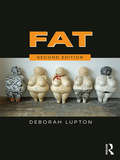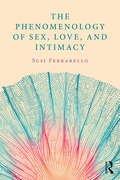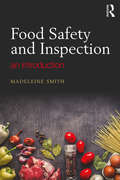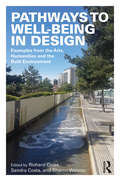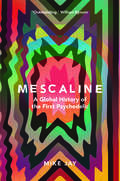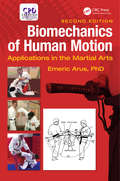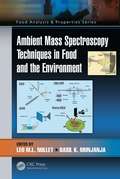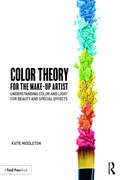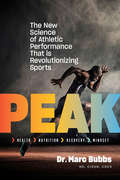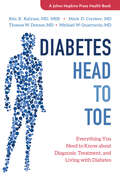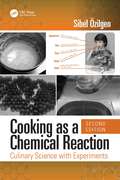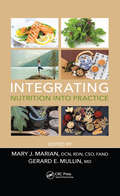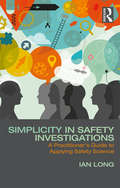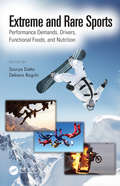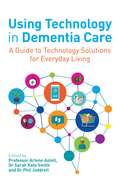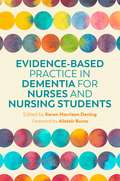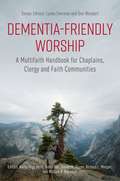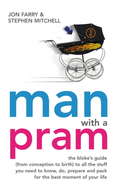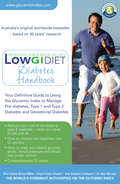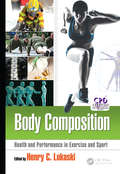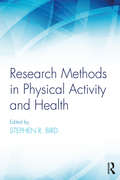- Table View
- List View
Fat
by Deborah LuptonIn contemporary western societies, the fat body has become a focus of stigmatizing discourses and practices aimed at disciplining, regulating and containing it. Despite the fact that in many western countries fat bodies outnumber those that are thin, fat people are still socially marginalized, and treated with derision and even repulsion and disgust. Medical and public health experts continue to insist that an ‘obesity epidemic’ exists and that fatness is a pathological condition which should be prevented and controlled. Fat is a book about why the fat body has become so reviled and reviewed as diseased, the target of such intense discussion and debate about ways to reduce its size down to socially and medically acceptable dimensions. It is about the lived experience of fat embodiment: how does it feel to be fat in a fat phobic-society? Fat activism and obesity politics, and related controversies, are also discussed. Internationally-renowned sociologist Deborah Lupton explores fat as a sociocultural artefact: a bodily substance or body shape that is given meaning by complex and shifting systems of ideas, practices, emotions, material objects and interpersonal relationships. This analysis identifies broader preoccupations and trends in the ways that human bodies and selfhood are experienced and practised. The second and much expanded edition of Fat is twice as long as the original edition. Lupton incorporates the very latest current critical scholarship and research offered in the humanities and social sciences on fat embodiment and fat politics. New updated material is presented in every chapter, including substantial additional sections on new digital media. Fat is a lively, at times provocative introduction for the general reader, as well as for students and academics interested in the politics of embodiment and health.
The Phenomenology of Sex, Love, and Intimacy
by Susi FerrarelloThe Phenomenology of Sex, Love, and Intimacy presents a phenomenological exploration of love as it manifests itself through sexual desires and intimate relationships. Setting up a unique dialogue between psychology and philosophy, Susi Ferrarello offers a perspective through which clinicians can inform their practice on diverse issues of human sexuality. Drawing on Husserl’s phenomenology, Ferrarello’s analysis of love spans a range of disciplines including psychology, theology, biology, epistemology, and axiology, as well as areas related to gender, consent, and political control. Combining Husserlian perspectives on ethics with a focus on lived-experience, this text will deepen therapists’ understanding of love as the subject of interdisciplinary inquiry and enable them to locate questions of sexuality and intimacy within an academic framework. With key theoretical principles included to allow clinicians to think through and clarify their practice, this book will be a valuable tool for sex therapists, marriage and family therapists, and counselors, as well as psychology and philosophy students alike.
Food Safety and Inspection: An Introduction
by Madeleine SmithThe process of food inspection relies on an inspector's understanding of the intrinsic hazards associated with individual foods. Whereas spoilage can usually be determined through a simple organoleptic assessment, the judgment of whether a food is fit for human consumption requires an evaluation of health hazards, many of which may not be apparent through physical assessment. Instead the inspector must analyse and integrate scientific and handling information to evaluate the potential health risk. Adulteration of foods is also becoming an increasing problem, and the complexity of the food supply chain requires an understanding of risk points to allow targeted inspection and assessment. Food Safety and Inspection: An Introduction focuses on food categories and describes common hazards associated with each, using published peer-reviewed research to explain and evaluate the health risk. It is a practical textbook designed to support the role of food inspection in a modern food industry. There are seven chapters looking at specific aspects of food safety, including a chapter on fraud and adulteration. This book summarises relevant published research to provide a scientific context for specific food safety issues, and is an essential read for anyone interested in becoming a food inspector.
Pathways to Well-Being in Design: Examples from the Arts, Humanities and the Built Environment
by Richard Coles Sandra Costa Sharon WatsonHow can we achieve and promote well-being? Drawing on examples from the arts, humanities and design, this book brings together work from a wide range of areas to reveal the unique ways in which different disciplines approach the universal goal of supporting well-being. Pathways to Well-Being in Design recognises that the distinction between academics and practitioners often becomes blurred, where, when working together, a fusion of thoughts and ideas takes place and provides a powerful platform for dialogue. Providing new insights into the approaches and issues associated with promoting well-being, the book's multi-disciplinary coverage invites readers to consider these ideas within the framework of their own work. The book's 12 chapters are authored by academics who are involved in practice or are working with practitioners and features real world case studies which cover a range of situations, circumstances, environments, and social groups. Pathways to Well-Being in Design responds to those wishing to enquire further about well-being, taking the reader through different circumstances to consider approaches, discussing practice and theory, real world and virtual world considerations. This book is essential reading for anyone seeking to understand well-being, including students and professionals in architecture, landscape architecture, urban planning, design and health sciences.
Mescaline: A Global History of the First Psychedelic
by Mike JayA definitive history of mescaline that explores its mind-altering effects across cultures, from ancient America to Western modernity Mescaline became a popular sensation in the mid-twentieth century through Aldous Huxley’s The Doors of Perception, after which the word “psychedelic” was coined to describe it. Its story, however, extends deep into prehistory: the earliest Andean cultures depicted mescaline-containing cacti in their temples. Mescaline was isolated in 1897 from the peyote cactus, first encountered by Europeans during the Spanish conquest of Mexico. During the twentieth century it was used by psychologists investigating the secrets of consciousness, spiritual seekers from Aleister Crowley to the president of the Church of Jesus Christ of Latter-day Saints, artists exploring the creative process, and psychiatrists looking to cure schizophrenia. Meanwhile peyote played a vital role in preserving and shaping Native American identity. Drawing on botany, pharmacology, ethnography, and the mind sciences and examining the mescaline experiences of figures from William James to Walter Benjamin to Hunter S. Thompson, this is an enthralling narrative of mescaline’s many lives.
Biomechanics of Human Motion: Applications in the Martial Arts, Second Edition
by Emeric Arus, Ph.D.This book covers the general laws governing human biomechanics through an extensive review of martial arts techniques and references to fundamental theory. Using straightforward mathematics and physics, this work covers indepth the anatomical foundation of biomechanics and physiological foundation of human motion through specific and relevant martial arts applications. This book also covers the kinematics and kinetics of biomechanics via examples from martial arts and their comparison to different sports techniques. It is written to be used and referenced by biomechanical professionals and martial arts enthusiasts.
Ambient Mass Spectroscopy Techniques in Food and the Environment (Food Analysis & Properties)
by Leo M.L. Nollet Basil K. MunjanjaAmbient mass spectrometry—that is the use of mass spec but in the atmospheric environment—has been widely employed in food and environmental analysis. Ambient Mass Spectroscopy Techniques in Food and the Environment presents the theoretical underpinnings of mass spectrometry, and the benefits and pitfalls of ambient mass spectrometry, as well as the latest developments of the technique, in the analysis of food and environmental parameters. It describes methods that enable the detection of surface materials like waxes, alkaloids, flavors, or pesticides by plainly exposing the corresponding items to the ionization region of the interface, without harm to samples. Features: Explains the theoretical aspects of ambient mass spectrometry Describes how to use ambient MS techniques for food safety, authenticity, and traceability screening Lists the benefits of ambient MS in analysis of food and environmental parameters Covers recent developments of ambient MS in analysis of food and environmental parameters The specialized work provides insight to professionals practicing in food and the environment, including food scientists, food engineers, food biotechnologists, chemical engineers, and those working in research labs, universities, and government regulatory agencies.
Color Theory for the Makeup Artist: Understanding Color and Light for Beauty and Special Effects
by Katie MiddletonColor Theory for the Make-up Artist: Understanding Color and Light for Beauty and Special Effects analyzes and explains traditional color theory for fine artists and applies it to the make-up artist. This book is suitable for both professionals and beginners who wish to train their eye further to understand and recognize distinctions in color. It explains why we see color, how to categorize and identify color, relationships between colors, and it relates these concepts to beauty and special effects make-up. The book teaches the reader how to mix flesh tones by using only primary colors, and explains how these colors in paints and make-up are sourced and created. It also discusses the reason for variations in skin colors and undertones, and how to identify and match these using make-up, while choosing flattering colors for the eyes, lips, and cheeks. Colors found inside the body are explained for special effects make-up, like why we bruise, bleed, or appear sick. Ideas and techniques are also described for painting prosthetics, in addition to using color as inspiration in make-up designs. The book also discusses how lighting affects color on film, television, theater, and photography sets, and how to properly light a workspace for successful applications.
Peak: The New Science of Athletic Performance That is Revolutionizing Sports
by Dr. Marc BubbsAn integrated and personalized approach to health, nutrition, training, recovery, and mindset There is a new revolution happening in sports as more and more athletes are basing their success on this game-changing combination: health, nutrition, training, recovery, and mindset. Unfortunately, the evidence-based techniques that the expert PhDs, academic institutions, and professional performance staffs follow can be in stark contrast to what many athletes actually practice. When combined with the noise of social media, old-school traditions, and bro-science, it can be difficult to separate fact from fiction. Peak is a groundbreaking book exploring the fundamentals of high performance (not the fads), the importance of consistency (not extreme effort), and the value of patience (not rapid transformation). Dr. Marc Bubbs makes deep science easy to understand, and with information from leading experts who are influencing the top performers in sports on how to achieve world-class success, he lays out the record-breaking feats of athleticism and strategies that are rooted in this personalized approach. Dr. Bubbs’s performance protocol is for the elite athlete, active individual, strength coach, nutritionist, or practitioner who wants to expand their potential by: Connecting the importance of sleep, digestion, the athlete microbiome, and blood glucose control metrics Creating personalized deep nutrition strategies for building muscle, burning fat, or “making weight” for competition Rethinking nutrition specifically for team sports Learning how elite endurance athletes fuel, including training techniques to boost performance Applying the new science of recovery that enhances performance Emphasizing the tremendous role of emotional intelligence and mindset in overcoming roadblocks and achieving athletic success (the next frontier in performance) Analyzing the qualities of elite leaders and how to develop them authentically Dr. Bubbs expertly brings together the worlds of health, nutrition, and exercise and synthesizes the salient science into actionable guidance. Regardless if you’re trying to improve your physique, propel your endurance, or improve your team’s record, looking at performance through this lens is absolutely critical for lasting success.
Diabetes Head to Toe: Everything You Need to Know about Diagnosis, Treatment, and Living with Diabetes (A Johns Hopkins Press Health Book)
by Thomas W. Donner Rita R. Kalyani Mark D. Corriere Michael W. QuartuccioDiabetes Head to Toe is an invaluable resource for anyone living with diabetes. It includes everything you should know about the disease;¢;‚¬;€?straight from the experts. The authors, all doctors who specialize in diabetes care, offer simple explanations and essential advice on all things diabetes. Accessible and concise, Diabetes Head to Toe presents information at a glance, with conversational prose and easy-to-digest bullet points. Each chapter begins with a short introduction and includes helpful sections on "What You Need to Know" and "What Does It All Mean?" Other notable features include "Tips," "Myths and Facts," and frequently asked questions. In addition to defining medical concepts in everyday language while tackling core topics, such as patient dietary needs and lifestyle changes, this book contains unique coverage of;€¢ how to prevent and diagnose diabetes ;€¢ the many complications;¢;‚¬;€?head to toe;¢;‚¬;€?that people with diabetes can develop ;€¢ diabetes in diverse populations, including children and adults;€¢ new treatments for diabetes and how they work;€¢ common interactions between diabetes medications and other drugs ;€¢ medical conditions that occur more frequently in people with diabetes, including eye disease, heart disease, kidney problems, depression, nerve damage, and sexual problems ;€¢ cutting-edge diabetes technologies and the costs, benefits, and limitations of various devices;€¢ legal considerations that everyone with diabetes should keep in mind More than 50 illustrations illuminate key points, while a two-color format allows readers to quickly identify the information they are seeking. Aimed at people with diabetes, family members, teachers, physicians, nurses, dietitians, pharmacists, specialists, and anyone else who cares about the health of diabetes patients, this up-to-date book will help readers recognize the early warning signs before diabetes-related difficulties arise, ensuring a long, healthy life.
Cooking as a Chemical Reaction: Culinary Science with Experiments, Second Edition
by Z. Sibel OzilgenWith this book, students are able to perform experiments and then make observations that they will frequently see in the kitchen and other food preparation and processing areas and learn the science behind these phenomena. The second edition of Cooking as a Chemical Reaction: Culinary Science with Experiments features new chapters on food hygiene and safety, kitchen terminology, and taste pairing, as well as an expanded chapter on the role of food additives in culinary transformations. The text uses experiments and experiences from the kitchen, and other food preparation areas, rather than theory, as the basic means of explaining the scientific facts and principles behind food preparation and food processing. It engages students in their own learning process. This textbook is designed so that students can first perform certain experiments and record their observations in tables provided in the book. The book then explains the science behind their observations. Features: Experiments and recipes form the basic means of teaching culinary chemistry Features new chapters on food hygiene and safety, kitchen terminology, and taste pairing Employs real kitchen practices to explain the subjects Covers traditional food chemistry including water in culinary transformations, protein, carbohydrates, fats, sensorial properties Many concepts throughout the book are marked with a symbol that indicates the concept is one that they will come across frequently not just in this text, but in the kitchen and other food preparation and processing areas. A second symbol precedes the scientific explanation of the observation made during the experiments in the chapter. At the end of each chapter, students are presented with important points to remember, more ideas to try, and study questions to reinforce concepts that were presented in the chapter. The book is designed for each chapter to be read and studied in chronological order, as the concepts of each chapter will reoccur in subsequent chapters. Written at the undergraduate level, this book is designed for students in culinary arts, nutrition, dietetics, food science and technology, and gastronomy programs. It is intended for students with limited scientific background who are studying different aspects of food preparation and processing.
Cooking as a Chemical Reaction: Culinary Science with Experiments, Second Edition
by Z. Sibel OzilgenWith this book, students are able to perform experiments and then make observations that they will frequently see in the kitchen and other food preparation and processing areas and learn the science behind these phenomena. The second edition of Cooking as a Chemical Reaction: Culinary Science with Experiments features new chapters on food hygiene and safety, kitchen terminology, and taste pairing, as well as an expanded chapter on the role of food additives in culinary transformations. The text uses experiments and experiences from the kitchen, and other food preparation areas, rather than theory, as the basic means of explaining the scientific facts and principles behind food preparation and food processing. It engages students in their own learning process. This textbook is designed so that students can first perform certain experiments and record their observations in tables provided in the book. The book then explains the science behind their observations. Features: Experiments and recipes form the basic means of teaching culinary chemistry Features new chapters on food hygiene and safety, kitchen terminology, and taste pairing Employs real kitchen practices to explain the subjects Covers traditional food chemistry including water in culinary transformations, protein, carbohydrates, fats, sensorial properties Many concepts throughout the book are marked with a symbol that indicates the concept is one that they will come across frequently not just in this text, but in the kitchen and other food preparation and processing areas. A second symbol precedes the scientific explanation of the observation made during the experiments in the chapter. At the end of each chapter, students are presented with important points to remember, more ideas to try, and study questions to reinforce concepts that were presented in the chapter. The book is designed for each chapter to be read and studied in chronological order, as the concepts of each chapter will reoccur in subsequent chapters. Written at the undergraduate level, this book is designed for students in culinary arts, nutrition, dietetics, food science and technology, and gastronomy programs. It is intended for students with limited scientific background who are studying different aspects of food preparation and processing.
Integrating Nutrition into Practice
by Mary J. Marian Gerard MullinIntegrative medicine is an approach to wellness that makes use of both conventional and alternative therapies to achieve optimal health and healing. Nutrition-based therapies are consistently among the highest used alternative therapies to treat a wide variety of illnesses. This book provides consumers and health care professionals with practical guidance on integrating nutrition therapies into disease prevention and management. It provides reliable and accurate information from experts in the nutrition field including dietitians, nutritionists, physicians, researchers, and academic professionals. Integrative Nutrition Therapy includes up-to-date information on dietary supplements, popular diets, physical activity, and food allergies. The book covers disease prevention for cancer, cardiovascular disease, diabetes, and obesity. Additional topics include liver/pancreatic conditions and musculoskeletal disorders as well as nutrigenomics, epigenetics, and metabolomics. The book provides evidence-based recommendations for which therapies might be appropriate for various conditions and discusses the possible adverse effects that may develop. It also includes guidelines and suggestions for creating individualized, integrative care plans. Integrative Nutrition Therapy is organized in a systematic manner that presents the scientific data using an evidence-based, how-to approach. An overview of integrative medicine is written by Dr. Roberta Lee, a leading authority in the field. Award-winning nutrition experts provide practical knowledge for the integrative practitioner, covering topics such as: Nutrition screening and assessment Search for the optimum diet Functional foods and nutritional supplements Nutritional recommendations for women’s health Health benefits of physical activity Diet and mental health Although unanswered questions still exist, this resource gives you a much-needed guide to the information currently available on nutrition and lifestyle-based therapies.
Simplicity in Safety Investigations: A Practitioner's Guide to Applying Safety Science
by Ian LongThis innovative book aims to bring the science of safety into a simple and practical approach to investigating workplace incidents. As a basis, it uses the ideas of some of the great safety science thinkers of our time. These include Sidney Dekker, Todd Conklin, Erik Hollnagel, Daniel Kahneman, James Reason and Dylan Evans, alongside others and the author’s own extensive industry experience. Simplicity in Safety Investigations: A Practitioner's Guide to Applying Safety Science will better equip readers to deal with incident investigations by helping them understand the science behind investigation techniques, and by exploring coaching and leadership styles that help them ask better questions both before and after workplace incidents. The first two chapters of the book focus on our mindset as we approach and undertake investigations, and the simple things we all must do before an investigation starts. The third chapter is a step-by-step guide on how to undertake both simple and more detailed workplace incident investigations. Chapter 4 is reserved for a more detailed review and set of explanations around the science and thinking behind the method and approach. This book serves as an easy-to-follow, real-world reference for supervisors, managers and safety practitioners across many industries.
Extreme and Rare Sports: Performance Demands Drivers Functional Foods And Nutrition
by Sourya Datta Debasis BagchiTwo crucial components of a healthy life are nutrition and exercise. The importance of appropriate diet, food and nutrition are extremely important to be successful in sports, and, especially, in extreme sports. Extreme sport is an activity where a participant must demonstrate both mental and physical skills. This type of activity provides an adrenaline rush to individuals who are part of the "community of extreme sportsmen." Extreme sports provide opportunity for individuals to be active and fit with added enjoyment of partaking in a fun activity. Extreme sports in conjunction with proper nutrition helps to boost immunity and resistance against common infections. Studies have also exhibited that sports and exercise activities help in managing effective work-life balance as well. Extreme and Rare Sports: Performance Demands, Drivers, Functional Foods, and Nutrition provides a comprehensive treatise on extreme sports emphasizing the importance of nutrition and research-driven nutraceutical supplements in injury prevention and treatment. The book presents information on the nutritional requirements of sports activities on land, in water, or with high altitude-base. It covers a wide variety of definitions, philosophies, thoughts and practices involved with structurally diverse extreme sports. Features: Discusses specific food and nutritional requirements in extreme sports Provides information on the importance of functional foods, nutrition and structurally diverse phytonutrients for different sports Features information on Olympic and diverse extreme sports Details the importance of hydration and use of gelatin; skeletal muscle damage and recovery from eccentric contractions; and information on dietary supplements and antioxidants Presents analysis on growth, marketing, techniques, and future of extreme sports
Using Technology in Dementia Care: A Guide to Technology Solutions for Everyday Living
by Arlene Astell Sarah Smith Phil JoddrellMany new pieces of technology can be beneficial to individuals living with dementia, including both hardware and software. This straightforward guide summarises the current research on this growing topic, and gives practical advice on how available technology can be used to improve the everyday lives of people with dementia.Looking at a range of available products, such as off-the-shelf computers and smartphones, to dementia specific applications and programs, it also addresses some common obstacles and barriers faced when introducing technology in dementia care. The past twenty years have seen an array of technologies developed to improve the day-to-day lives of people with dementia; this guide shows how they can be effectively used.
Using Technology in Dementia Care: A Guide to Technology Solutions for Everyday Living
by Arlene Astell Sarah Smith Phil JoddrellMany new pieces of technology can be beneficial to individuals living with dementia, including both hardware and software. This straightforward guide summarises the current research on this growing topic, and gives practical advice on how available technology can be used to improve the everyday lives of people with dementia.Looking at a range of available products, such as off-the-shelf computers and smartphones, to dementia specific applications and programs, it also addresses some common obstacles and barriers faced when introducing technology in dementia care. The past twenty years have seen an array of technologies developed to improve the day-to-day lives of people with dementia; this guide shows how they can be effectively used.
Evidence-Based Practice in Dementia for Nurses and Nursing Students
by Karen Harrison Harrison Dening Alistair Burns Malarvizhi Babu Sandilyan Tom Dening Hilda Hayo Chris Knifton Caroline Baker Jan Leeks Esme Moniz-Cook Aileen Beatty Julian C. Hughes Sarah Rhynas Charlotte L. Clarke Jill Manthorpe Stephen Martineau Jane Youell Helen Scott Zena Aldridge Frances Bunn Claire Goodman Cheryl Holman Angela Moore Liz Sampson Jo Moriarty Steve Iliffe Katie Featherstone Andy Northcott Sharon TolmanThis essential textbook on dementia care introduces the knowledge that nurses need, including the evidence base for practice and the guidance to transfer this newly acquired knowledge into everyday practice. Each of the 25 chapters are written by experts in the field of dementia care and are grounded in thoroughly researched, up-to-date evidence, have a direct bearing to nurse practice, and use case studies to give examples of application of the evidence to practice.It begins by introducing dementia as a diagnosis, a syndrome, and a set of diseases, signs and symptoms. It then deals with various principles that underpin dementia care, including person-centred care, behaviours that challenge, risk management, and understanding relationships affected by dementia. Finally, it assesses dementia care across a range of care settings, such as primary care, care homes, domiciliary care, acute hospital, and hospice services.
Evidence-Based Practice in Dementia for Nurses and Nursing Students
by Karen Harrison Harrison Dening Alistair Burns Malarvizhi Babu Sandilyan Tom Dening Hilda Hayo Chris Knifton Caroline Baker Jan Leeks Esme Moniz-Cook Aileen Beatty Julian C. Hughes Sarah Rhynas Charlotte L. Clarke Jill Manthorpe Stephen Martineau Jane Youell Helen Scott Zena Aldridge Frances Bunn Claire Goodman Cheryl Holman Angela Moore Liz Sampson Jo Moriarty Steve Iliffe Katie Featherstone Andy Northcott Sharon TolmanThis essential textbook on dementia care introduces the knowledge that nurses need, including the evidence base for practice and the guidance to transfer this newly acquired knowledge into everyday practice. Each of the 25 chapters are written by experts in the field of dementia care and are grounded in thoroughly researched, up-to-date evidence, have a direct bearing to nurse practice, and use case studies to give examples of application of the evidence to practice.It begins by introducing dementia as a diagnosis, a syndrome, and a set of diseases, signs and symptoms. It then deals with various principles that underpin dementia care, including person-centred care, behaviours that challenge, risk management, and understanding relationships affected by dementia. Finally, it assesses dementia care across a range of care settings, such as primary care, care homes, domiciliary care, acute hospital, and hospice services.
Dementia-Friendly Worship: A Multifaith Handbook for Chaplains, Clergy, and Faith Communities
by Virginia Biggar Lynda Everman Rabbi Steven M. GlazerReligious faith is a powerful source of comfort and support for individuals and families facing dementia. Many faith leaders need help in adapting their ministries to address the worship/spiritual needs of this group. A product of Faith United Against Alzheimer's, this handbook by 45 different authors represents diverse faith traditions, including Christianity, Islam, Judaism, Sikhism, Buddhism and Native American. It provides practical help in developing services and creating dementia friendly faith communities. It gives an understanding of the cognitive, communicative and physical abilities of people with dementia and shows what chaplains, clergy and lay persons can do to engage them through worship. Included are several articles by persons living with dementia.
Dementia-Friendly Worship: A Multifaith Handbook for Chaplains, Clergy, and Faith Communities
by Virginia Biggar Lynda Everman Rabbi Steven M. GlazerReligious faith is a powerful source of comfort and support for individuals and families facing dementia. Many faith leaders need help in adapting their ministries to address the worship/spiritual needs of this group. A product of Faith United Against Alzheimer's, this handbook by 45 different authors represents diverse faith traditions, including Christianity, Islam, Judaism, Sikhism, Buddhism and Native American. It provides practical help in developing services and creating dementia friendly faith communities. It gives an understanding of the cognitive, communicative and physical abilities of people with dementia and shows what chaplains, clergy and lay persons can do to engage them through worship. Included are several articles by persons living with dementia.
Man with a Pram: The bloke's guide to all the stuff you need to know, prepare, paint, pack, do and fix - for the best moment of your life
by Jon Farry Stephen MitchellThis is the essential pregnancy guide for dads-to-be and comes complete with must-have man-centric checklists so you won't forget anything. From the joys of conception, the pain of labour and the exhilaration of birth, this easy-to-read book will empower you with authentic, reassuring, realistic, bloke-authoritative advice so you can be the most supportive and useful partner ever for your pregnant other half. This is more than what to expect, it is what to do...for blokes. Congratulations and enjoy the ride.
Low GI Diet Diabetes Handbook (The Low GI Diet)
by Professor Jennie Brand-Miller Kaye Foster-Powell Professor Stephen Colagiuri Dr Alan BarclayFor the first time, this bestselling handbook is available as an ebook. Diabetes is one of the fastest growing diseases in the world and is a contributing factor to the high rates of heart disease. It can also cause health problems related to blindness, kidney failure and amputation. In Australia and New Zealand diabetes and pre-diabetes affect 1 in 4 people. Every day nearly 300 adults and even children develop type 2 diabetes - and for every person diagnosed with diabetes there's someone with undiagnosed diabetes. The good news is that these days we know a lot more about managing diabetes and reducing your risk of developing it. THE DIABETES & PRE-DIABETES HANDBOOK cuts through the conflicting advice and sets out clearly and simply what you need to eat and do to help you: reduce your body fat; improve your insulin sensitivity; improve your cardiovascular health; keep your blood glucose levels near the normal range. This book is a practical guide to help you manage your diabetes or pre-diabetes with diet and lifestyle. The authors show what you can do for yourself - and why. Best of all, the information in this book is good advice for all members of your family, not just you.
Body Composition: Health and Performance in Exercise and Sport
by Henry C. LukaskiInterest in the relationships between body structure and function in physical activity has persisted for centuries. Body Composition: Health and Performance in Exercise and Sport advances understanding beyond simple descriptions of body physique and composition of athletes and fills gaps in our understanding of the important role of muscle, fat, and bone in facilitating physical performance and health in sports and physically demanding occupations. lt addresses basic, practical, and applied topics in body composition, performance, and health with comprehensive reviews organized in four logical parts: Body Composition Assessment; Physical Activity and Body Composition; Body Composition in Sports and Occupations; and Moderating Factors. This book integrates state-of-the-art knowledge by international experts in the field and produces an evidence-based practical guide for a balanced understanding of the role and use of body composition assessment in physical performance and health for youth and adults. It also provides a needed link between the practice of body composition assessment and its application by members of public health advisory committees that develop national guidelines for diet, physical activity, and health. This book is suitable for students and professionals in sports nutrition, exercise science, kinesiology, and athletic training. Sport administrators and policy-makers for international and national sport federations and organizations, and national intercollegiate and scholastic federations, would also benefit from this book.
Research Methods in Physical Activity and Health
by Stephen R. BirdPhysical activity is vital for good health. It has an established strong evidence base for its positive effects on functional capacity, reducing the risk of many chronic diseases, and promoting physical, mental and social well-being. Furthermore, these benefits are evident across a diversity of ages, groups and populations. The need for these benefits in current societies means that exercise practitioners, professional bodies, institutions, health authorities and governments require high quality evidence to establish appropriate exercise guidelines, implementation strategies and effective exercise prescription at individual, group and population levels. Research Methods in Physical Activity and Health is the first book to comprehensively present the issues associated with physical activity and health research and outline methods available along with considerations of the issues associated with these methods and working with particular groups. The book outlines the historical and scientific context of physical activity and health research before working through the full research process, from generating literature reviews and devising a research proposal, through selecting a research methodology and quantifying physical activity and outcome measures, to disseminating findings. Including a full section on conducting research studies with special populations, the book includes chapters on: Observational and cross-sectional studies; Interviews, questionnaires and focus groups; Qualitative and quantitative research methods; Epidemiological research methods; Physical activity interventions and sedentary behaviour; and Working with children, older people, indigenous groups, LGBTI groups, and those with physical and mental health issues. Research Methods in Physical Activity and Health is the only book to approach the full range of physical activity research methods from a health perspective. It is essential reading for any undergraduate student conducting a research project or taking applied research modules in physical activity and health, graduate students of epidemiology, public health, exercise psychology or exercise physiology with a physical activity and health focus, or practicing researchers in the area.
